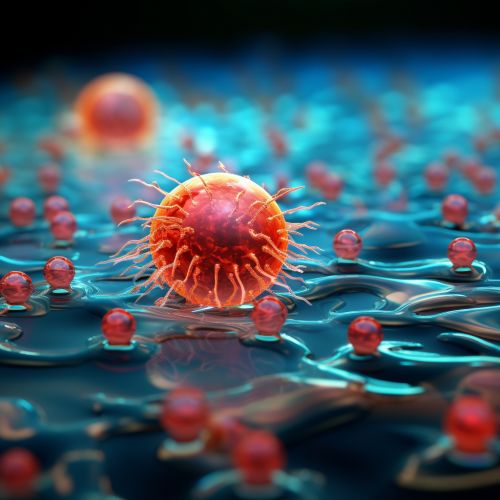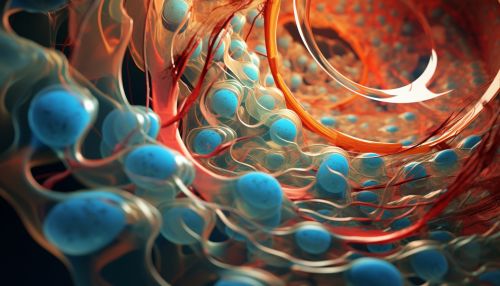Osmotic stress
Introduction
Osmotic stress is a phenomenon that occurs when there is a sudden change in the solute concentration around a cell, causing a rapid change in the movement of water across its membrane. This can lead to significant changes in cell size and shape, and can even result in cell death if the stress is too severe or prolonged. Osmotic stress can be caused by a variety of factors, including changes in the external environment, disease, and injury.


Causes of Osmotic Stress
Osmotic stress can be caused by a variety of factors, both external and internal. External factors can include changes in the environment, such as a sudden increase or decrease in the concentration of solutes in the water or soil in which the cell resides. This can occur due to natural phenomena, such as rainfall or evaporation, or as a result of human activity, such as the addition of fertilizers or other chemicals to the environment.
Internal factors can include disease or injury, which can cause a sudden change in the concentration of solites within the cell itself. This can lead to a rapid influx or efflux of water, causing the cell to swell or shrink rapidly.
Effects of Osmotic Stress
The effects of osmotic stress on a cell can be severe and varied. At a basic level, osmotic stress can cause a cell to swell or shrink rapidly. This can lead to changes in cell shape and size, which can in turn affect the cell's ability to function properly.
In more severe cases, osmotic stress can lead to cell death. This can occur if the stress is too severe or prolonged, and the cell is unable to adapt to the changes in water movement. This can lead to a condition known as osmotic lysis, in which the cell membrane ruptures and the cell's contents are released into the surrounding environment.
Cellular Response to Osmotic Stress
Cells have developed a variety of mechanisms to cope with osmotic stress. These can include changes in cell membrane permeability, the production of osmoprotective compounds, and changes in gene expression.
Changes in cell membrane permeability can help to regulate the movement of water in and out of the cell. This can be achieved through the action of aquaporins, proteins that form channels in the cell membrane through which water can pass.
The production of osmoprotective compounds, such as trehalose and proline, can help to protect the cell from the effects of osmotic stress. These compounds can act as osmolytes, helping to maintain the cell's osmotic balance and prevent excessive water loss or gain.
Changes in gene expression can also help the cell to adapt to osmotic stress. This can involve the upregulation of genes involved in osmoprotection, and the downregulation of genes that may exacerbate the effects of osmotic stress.
Osmotic Stress in Plants
Osmotic stress is a particularly important issue for plants, as they are often exposed to changing environmental conditions that can cause changes in the concentration of solutes in the soil. This can lead to osmotic stress, which can affect plant growth and development.
Plants have developed a variety of mechanisms to cope with osmotic stress. These can include changes in root architecture, the production of osmoprotective compounds, and changes in gene expression.
Changes in root architecture can help plants to access water in deeper layers of the soil, helping to mitigate the effects of osmotic stress. This can involve changes in root length, branching, and hair production.
The production of osmoprotective compounds, such as trehalose and proline, can help to protect plant cells from the effects of osmotic stress. These compounds can act as osmolytes, helping to maintain the cell's osmotic balance and prevent excessive water loss or gain.
Changes in gene expression can also help plants to adapt to osmotic stress. This can involve the upregulation of genes involved in osmoprotection, and the downregulation of genes that may exacerbate the effects of osmotic stress.
Osmotic Stress in Microorganisms
Like plants and animals, microorganisms can also be affected by osmotic stress. This can be a particular issue for microorganisms that live in environments where the concentration of solutes can change rapidly, such as the ocean or a salt lake.
Microorganisms have developed a variety of mechanisms to cope with osmotic stress. These can include changes in cell membrane permeability, the production of osmoprotective compounds, and changes in gene expression.
Changes in cell membrane permeability can help to regulate the movement of water in and out of the cell. This can be achieved through the action of aquaporins, proteins that form channels in the cell membrane through which water can pass.
The production of osmoprotective compounds, such as trehalose and proline, can help to protect the cell from the effects of osmotic stress. These compounds can act as osmolytes, helping to maintain the cell's osmotic balance and prevent excessive water loss or gain.
Changes in gene expression can also help the cell to adapt to osmotic stress. This can involve the upregulation of genes involved in osmoprotection, and the downregulation of genes that may exacerbate the effects of osmotic stress.
